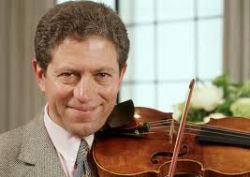|
Symphony
MYSTICAL PLANETS AND LIVELY GERSHWIN ORTIZ AT FINAL SRS CONCERT
by Peter Lert
Sunday, May 4, 2025
Symphony
VSO'S CONCERT MUSIC OF TIME, MUSIC OF PLACE
by Peter Lert
Sunday, April 27, 2025
Choral and Vocal
VOCAL ELEGANCE AND FIRE AT THE 222'S RECITAL APRIL 26
by Pamela Hicks Gailey
Saturday, April 26, 2025
CANTIAMO SONOMA SINGS AN INSPIRED GOOD FRIDAY MOZART REQUIEM CONCERT
by Pamela Hicks Gailey
Friday, April 18, 2025
DRAMATIC SHOSTAKOVICH SYMPHONY CLOSES PHILHARMONIC'S 25TH SEASON
by Terry McNeill
Sunday, April 13, 2025
LARGE COLLEGE OF MARIN AUDIENCE GREETS STOPHER ARTISTRY
by Terry McNeill
Saturday, April 5, 2025
Chamber
FRISSON DELIVERS SHIVERS OF DELIGHT
by Abby Wasserman
Sunday, March 30, 2025
OLD AND MOSTLY NEW IN SRS MARCH CONCERT IN WEILL
by Peter Lert
Saturday, March 22, 2025
Symphony
TWO FORMIDABLE SYMPHONIES AND PURPLE MOUNTAINS AT SRS CONCERT
by Peter Lert
Sunday, February 23, 2025
Chamber
THE PARKER CAPTURES DEMANDING ADES QUARTET AT RAC SEBASTOPOL CONCERT
by Peter Lert
Saturday, February 15, 2025
|
 |
 Violinist Alexander Barantschick |
IN THE PRIME OF YOUTH
by Steve Osborn
Thursday, January 23, 2014
Youth was the order of the day at the San Francisco Symphony's Jan. 23 concert in Weill Hall. Three of the four pieces on the program were written by teenaged composers--Mozart, Mendelssohn, Britten--and the fourth, by Piazzolla, included a youthful tango.
On the other hand, most of the musicians were middle-aged. There were only two dozen or so, a remarkably diminished version of an ensemble that had numbered well over 100 in its last appearance at Weill Hall, to play Richard Strauss's mammoth "Alpine Symphony." This time the orchestra was restricted to 14 violins, three violas, four cellos and two basses. Later they added a bandoneón player, a pianist and a drummer.
It was somewhat incongruous to see the drum set looming behind the orchestra in the opening work, Mozart's Divertimento in F major, K. 138, written when he was 16. Instead of the drums, the rhythm was supplied by the violas and cellos, who subsisted on a steady diet of eighth notes beneath the violins' soaring melodies. The putative conductor was Concertmaster Alexander Barantschik, but he did little more than lift his bow and occasionally nod at the cellos and basses from his first-chair position.
No conductor was needed in any event. The musicians played as one, with a remarkable unanimity of timbre, tempo and dynamics. The result was youth incarnate: Mozart shining forth in all the glory of his genius. Of the three movements, the second was the most memorable. Its beatific melody evoked Alpine clouds floating over Mozart's native Salzburg, their motion assisted by superb dynamics and evocative playing.
The milieu for the next piece shifted to the Mendelssohn family's sumptuous parlor in Berlin, where young Felix regularly trotted out new compositions for the assembled guests. This one was a violin concerto composed when he was 13, definitely not to be confused with his later masterful effort in the genre.
Standing up from his chair, Barantschik faced the audience, with the orchestra at his back. Playing from score, he never once turned around to conduct, relying once again on the musicians' collective unconscious. In comparison to the youthful Mozart, the youthful Mendelssohn is mostly superficial, given to glittering runs and crowd-pleasing cadenzas. The concerto, which had been forgotten for more than a century before being revived by Yehudi Menuhin, is pleasant but insubstantial.
Like the concerto, Barantschik's playing dwelled on the surface, without too much emotional investment. He has an almost flawless technique and uses minimal body motion, much like his fellow Russian predecessor Jascha Heifetz, one of whose violins he plays. The only oddity is that he grips his bow well up the stick, almost in Baroque position, avoiding his frog like the plague.
The lush sound of orchestra and soloist was remarkably consistent throughout the concerto, even during the slow second movement, which was disrupted by a medical emergency at the back of the hall. Undeterred, Barantschik played without pause, plunging into the gypsy-inspired final movement with alacrity. The long cadenza at the end was a perpetuum mobile that elicited loud applause.
Although Benjamin Britten completed his "Simple Symphony" when he was 20, the four movements are all based on pieces he wrote from the ages of 10 to 13. He is much closer to Mozart than Mendelssohn, opting for heartfelt simplicity rather than superficial complexity. The second movement, "Playful Pizzicato," is especially charming, from the resonant bass plucking to the sudden intrusion of folksong-like strumming. Again, the conductorless orchestra played with remarkable coherence, with everyone on the same dynamic and beat.
Youth succumbed to old age in the final piece(s), the "Melodia" and "Libertango" of Astor Piazzolla, adapted for string orchestra, solo violin and bandoneón by Jeremy Cohen, who also wrote a violin cadenza linking the two. Barantschik again took the solo role, joined by bandoneón player Seth Arsanow.
For those unfamiliar with the bandoneón, it resembles an accordion, with a bellows in the middle and keys on either end--but the bandoneón bellows are much longer than an accordion's and are draped across the player's knee like a massive snake. Their undulating movement becomes as much a part of the performance as the sound they produce.
Arsarnow played his instrument superbly, creating heart-breaking sounds that echoed throughout the hall. The opening "Melodia" was pure romance, a welter of emotions in a melancholy frame. After the transitional violin cadenza, Arsarnow started the concluding youthful tango by tapping the bandoneón with his right hand. The drums entered, and soon the entire orchestra was figuratively prancing across the stage to the tango's distinctive rhythm. The crowd loved it, leaping to their feet at the end.
|
